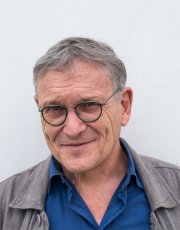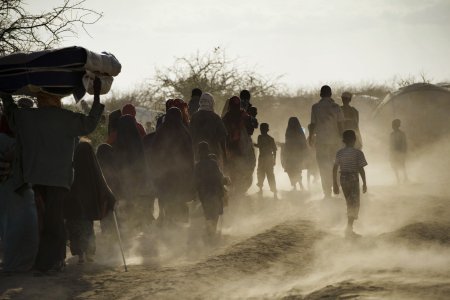
When camps become cities
Rony Brauman
There can scarcely be any more sensitive marker of geopolitical transformations than the refugee. Not the individual refugee as such, but the phenomenon of refugees, the representations that make them visible and the discourse around them. From this point of view, 2016 was a year of upheaval, the like of which Europe had not seen since the war in the former Yugoslavia (1991-1995), which European governments managed from the perspective of containing the influx: two million people were estimated to have been internally displaced, with only a tiny proportion of them reaching the border. While they disagreed on the political solution to the conflict, the European powers managed to act together to contain it within Yugoslavia’s territorial boundaries. Refugee camps no longer had a place in Europe: the former Yugoslavia was to become a model for the international management of refugees or displaced people. We should remember that, according to the terminology of humanitarian law, a refugee is someone fleeing persecution or violence and is outside his own country; if they flee their home but remain within their country of nationality, they are classed as a “displaced person”. UNHCR, the UN agency responsible for providing assistance and protection to refugees, was granted authority to act on behalf of displaced persons for the first time during the war in the former Yugoslavia.
Far from being a simple bureaucratic extension of its field of activities, UNHCR’s new powers marked a shift in the perception and management of the movement of people in countries at war and neighbouring areas. Until then, i.e. during the Cold War, the refugee camp was the model, even the emblem, of these situations: the number of refugees had increased constantly since the late 1970s, resulting from an intensification of conflicts in the confrontation between East and West. While détente was on the agenda in Europe, this was not the case in what was still known as the third world. Conflicts were raging in central America, southern and eastern Africa and central Asia, prompting an exodus of millions of people seeking to escape the war or, in the case of countries in Indochina that had adopted communism, fleeing oppression. Between 1976 and 1983, the number of refugees identified by UNHCR increased from three to almost twelve million. Mainly living together in camps where their safety was assured, albeit at the expense of their freedom, they benefited from international assistance delivered through NGOs. The camps were more than simply the epitome of humanitarian space: they were also sanctuaries for the guerrilla forces operating in the country of origin, who used them for recruitment and for various resources. In both respects, the camps were part of the Cold War system, both because they confirmed the failure of communism (90% of refugees were fleeing a regime or war supported by the Soviets) and because they were an instrument in the fight against it. Most of the camps gradually disappeared during the years that followed the end of the Cold War, with most refugees returning to their country of origin when the conflict had ended, or settling in their host country; only a tiny minority were resettled in a Western country.
With the disappearance of the USSR, the refugee camps lost their strategic value; nonetheless, armed conflicts did not disappear alongside them. Forced movements of people have therefore continued, with Afghanistan remaining, during the wars that followed its invasion by the Red Army, one of the main “producers” of refugees and displaced persons. However, it is mainly within the countries concerned that international aid has been implemented, with the emphasis on deployments of peacekeeping forces according to the Yugoslavian “model” referred to earlier. The conflict in Darfur (2004-...) in Sudan is one illustration, with the number of refugees in Chad (around 250,000) out of all proportion to those displaced internally (two million). We should note, nonetheless, that the civil war in South Sudan (2013-...) has driven over 200,000 people into Ethiopia and recently, 500,000 into neighbouring Uganda; the lives of the latter are not deemed to be at risk, unlike the lives of 6,000 asylum seekers in Calais according to some in France.
The United Nations estimates the number of forcibly displaced people worldwide at 65.3 million, of whom 21.3 million are refugees, including 5.2 million Palestinians. The latter – refugees from the war of 1948 and their descendants – have been specifically counted and placed under the responsibility of a dedicated United Nations agency, UNRWA: their exile predates the 1951 Refugee Convention, which created UNHCR. They live in specific neighbourhoods in Gaza, the West Bank and Lebanon. These are sometimes referred to as “camps”; although to the naked eye there is nothing to distinguish them from other housing, they are universally viewed as distinct urban areas.
Do these urban camps, home to the oldest refugees of our times, prefigure the future of refugees and displaced persons? While it would be wrong to generalise, it is fair to say that the phenomenon is growing. The biggest “producer” of refugees and displaced persons today is Syria: four million Syrians have left their country and double that number are internally displaced, with a third of them living in camps. Others are dispersed within the local population. The “camps” in Darfur, which housed two million villagers who were chased from their homes at the height of the war, became outlying neighbourhoods of the towns in the province. The same applies to the Dadaab camps in Kenya, which date back to 1992 and now house 400,000 Somalians fleeing the war that has been waged in their country for 25 years. An entire generation was born here, a place that is no longer a camp but not a town either, and whose inhabitants are still foreigners in the eyes of the Kenyan authorities, who threaten to send them back to Somalia. The displaced people in Darfur are still Sudanese and therefore not faced with the same threat of expulsion that hangs over the Somalians in Dadaab. As for the Palestinian refugees, who can say what fate awaits them on the West Bank and in Lebanon? Hidden behind the common face of camps that have grown into urban areas lie radically different human and political realities. Because settling the conflicts that lie behind them is a pious hope in the short term, the countries concerned and the aid system are forced to deal with the most urgent matters first: in this case, supporting a programme of urbanisation, helping people to resettle in a host country, including in Europe, and assisting in partial repatriation. The time when refugee camps represented a critical but fleeting moment is resolutely over.
This article was originally published in Alternatives Economiques #366, in French.
To cite this content :
Rony Brauman, “When camps become cities”, 6 mars 2017, ISSN : 101010, URL : https://msf-crash.org/en/camps-refugees-idps/when-camps-become-cities
If you would like to comment on this article, you can find us on social media or contact us here:
Contribute


